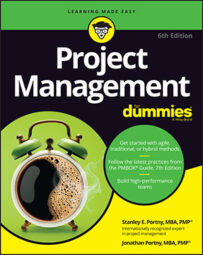Regardless of who maintains the template, it reflects people’s cumulative experiences. As the organization continues to perform projects of this type, stakeholders that were overlooked in earlier efforts may be added and stakeholders that proved unnecessary removed. Using these templates can save you time and improve your accuracy.
Suppose you prepare the budget for your department each quarter. After doing a number of these budgets, you know most of the people who give you the necessary information, who draft and print the document, and who have to approve the final budget. Each time you finish another budget, you revise your stakeholder register template to include new information from that project. The next time you prepare your quarterly budget, you begin your stakeholder register with your template. You then add and subtract names as appropriate for that particular budget preparation.
When using stakeholder register templates, keep the following guidelines in mind:
- Develop templates for frequently performed tasks and for entire projects. Stakeholder register templates for kicking off the annual blood drive or submitting a newly developed drug to the Food and Drug Administration are valuable. But so are templates for individual tasks that are part of these projects, such as awarding a competitive contract or printing a document. Many times, projects that appear totally new actually contain some tasks that you’ve done before. You can still reap the benefits of your prior experience by including the stakeholder register templates for these tasks in your overall project stakeholder register.
- Focus on position descriptions rather than the names of prior stakeholders. Identify a stakeholder as accounts payable manager rather than Bill Miller. People come and go, but functions endure. For each specific project, you can fill in the appropriate names.
- Develop and modify your stakeholder register template from previous projects that actually worked, not from initial plans that looked good but lacked key information. Often you develop a detailed stakeholder register at the start of your project but don’t revise the register during the project or add stakeholders whom you overlooked in your initial planning. If you update your template with information from an initial list only, your template can’t reflect the discoveries you made throughout the earlier project.
- Encourage your team members to brainstorm possible stakeholders before you show them an existing stakeholder register template. Encouraging people to identify stakeholders without guidance or restrictions increases the chances that they’ll think of stakeholders who were overlooked on previous projects.
- Use templates as starting points, not ending points. Make clear to your team that the template isn’t the final register. Every project differs in some ways from similar ones. If you don’t critically examine the template, you may miss people who weren’t involved in previous projects but whom you need to consider for this one.
- Reflect your different project experiences in your stakeholder register templates. The post-project evaluation is an excellent time to review, critique, and modify your stakeholder register for a particular project.
Templates can save time and improve accuracy. However, starting with a template that’s too polished can suggest you’ve already made up your mind about the contents of your final list, which may discourage people from freely sharing their thoughts about other potential stakeholders. In addition, their lack of involvement in the development of the project’s audience list may lead to their lack of commitment to the project’s success.

